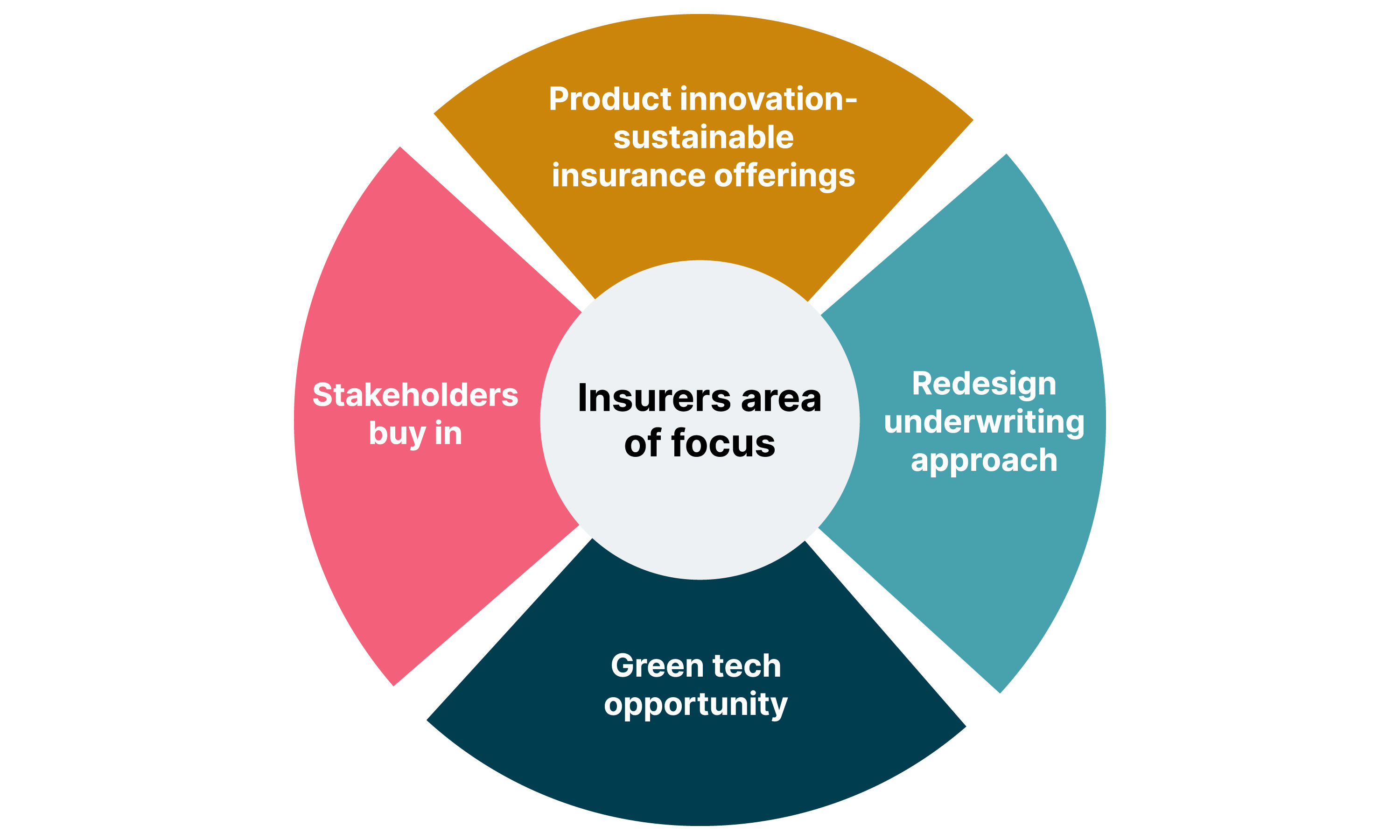Simon Kofe, the foreign minister of Tuvalu, delivered a powerful message standing knee-deep in sea water at the recent United Nations (UN) COP26 climate summit. “We cannot wait for the speeches when the sea is rising around us all the time. Climate mobility must come to the forefront. We must take bold alternative action today to secure tomorrow,” he said.
The pressure on organizations to strictly comply with green norms is increasing. Organizations that are slow to begin their transition might end up facing negative brand and financial consequences.
Insurance companies can play a multifaceted role in shaping the various risks posed by climate change. In just the first half of 2021, insured losses from natural disasters hit a 10-year high of a staggering USD 42 billion. In September 2021, the damage from Hurricane Ida was estimated at a cost between USD 31 billion and USD 44 billion in insured losses.
The insurance industry, while impacted by insured losses can also play an influential role as an investor. According to S&P Global, insurers own nearly 10 percent of the world's invested assets. So they can be influential in determining how capital will flow toward sectors, projects and technologies to help achieve a commitment to containing global warming at 1.5 degrees celsius.
Here are some broad categories of risks posed by climate change on insurers:
| Physical | The physical risks of climate change are varied and global – including chronic risks like extreme heat, drought and water access alongside acute risks like wildfires, hurricanes and flooding. These events can directly increase insurers’ exposure to large claims and losses in property , agriculture, life, health and liability insurance policies. |
| Transition | As the industry works to reduce its reliance on high-carbon industries and encourage newer fuels, there is risk to formulate and adopt new strategies, policies, underwriting approaches and investments by insurers. Several insurers have already committed to exit coal financing or speed up their efforts to do so. |
| Legal | Climate change litigation is on the rise. The liability risks associated with climate change are being brought into sharp focus for many organizations. Property insurance represents the main risks caused by a changed climate. Director & Officers (D&O) insurance policies are a main area of focus as there are several lawsuits alleging that a corporation has not properly disclosed its climate change-related vulnerabilities to investors under state and federal regulations. |
| Reputational | With customers and communities becoming more aware of climate change's impact, there is risk of certain insurance organizations being perceived as organizations enabling companies and businesses that hurt the environment. On the contrary it can also be an opportunity for some insurance companies to bolster their reputation by enabling or supporting more sustainable projects.
|
Insurers field of play
There is no single answer to climate change and the focus on sustainability would require considerable investment and consistent focus by insurers. Some of the key areas of play for insurance companies include:


The four areas of focus for insurers trying to positively impact climate change
Introduce innovative and sustainable insurance offerings
Insurers are now developing more environmental, social and governance (ESG)-friendly products.
Parametric insurance is a non-traditional insurance product that offers pre-specified payouts based on a trigger event. Trigger events depend on the nature of the parametric policy and can include environmental triggers, such as wind speed and rainfall measurements, etc. It is specifically helpful for the agricultural sector.
An example of a parametric insurance product is the protection of coral reefs in the state of Quintana Roo in Mexico. Swedish Insurance Fintech, Omocon has developed a microinsurance product for the sharing economy, involving shareable goods rented out on a platform. The product protects the owner of a shareable good or asset that needs protection against damage.
We are also seeing insurers providing incentives and discounts to customers who adopt green practices to reduce their energy consumption. For example, Allstate ‘pay as you drive’ and homeowners whose house or condo is already LEED-certified can avail a percentage off their home or condo insurance.
Redesign the underwriting approach using data
Every insurer should integrate and process diversity risk into risk management systems. ESG screening helps insurers not only manage their financial risk exposure but also their reputational risk exposure. Insurers have to improve their use of data to engage in price differentiation and risk assessment.
Swiss Re was one of the first companies to adopt an integrated risk management framework for risks like climate change, water, human rights etc., into one framework. The UN net zero asset owners’ alliance has committed to making its insurers’ portfolios carbon neutral by 2050.
Seize the green tech opportunity
A recently published Perspectives article by Thoughtworks highlighted that digitalization is not always environment friendly. The IT industry is already as big an emitter as aviation and it will account for close to 10 percent of global electricity demand by 2030. However, new solutions in areas like AI and cloud computing are also making more sustainable approaches possible. Research firm IDC, for example, estimates the efficiencies realized through cloud computing could prevent the emission of over one billion tons of carbon dioxide by 2024.
Insurers must determine a vision for their IT department and take into consideration ESG factors before starting on any new project.
Obtain the stakeholders’ buy-in
As shared in the same publication on digital sustainability, real progress depends on helping everyone in the company connect with the vision of the planned evolution. It is a process that depends on 'empathy, patience and communication.'
It is important for an insurance company to adopt a holistic approach in dealing with risks. Insurers need to not just focus on employees but also engage with agents, brokers, customers and external stakeholders such as regulators, investors and others. Bringing a range of senior leaders on board can help ensure sustainability goals are connected to financial realities, which contribute to their longevity and overall organizational buy-in.
In conclusion, the insurance industry has conventionally been slow to accept change. But in the role of managing climate change, insurers will need to make swift changes to assess and address climate change risks as not just risks but instead look at it as an opportunity to create value for their business and society at large.
Disclaimer: The statements and opinions expressed in this article are those of the author(s) and do not necessarily reflect the positions of Thoughtworks.


















